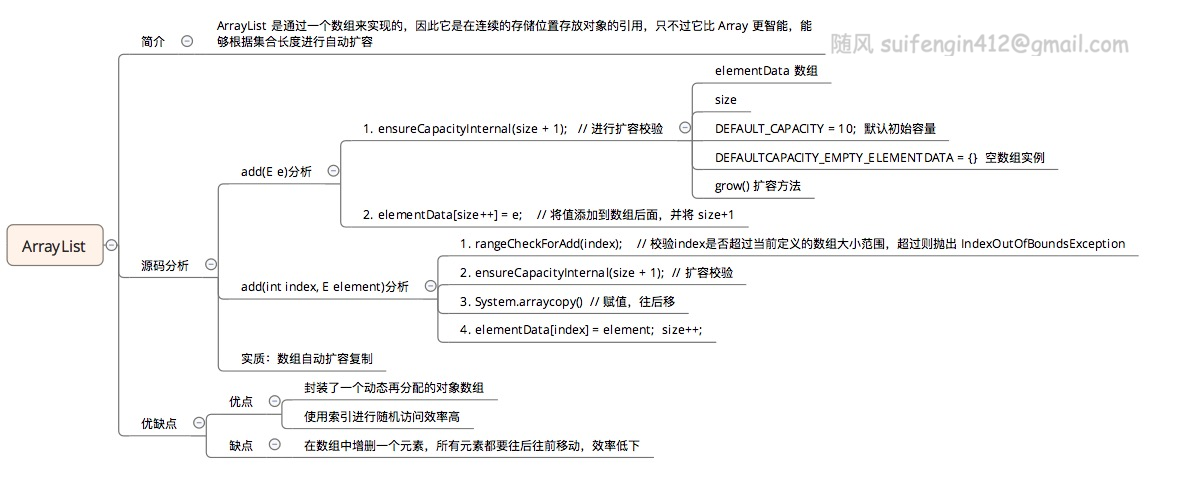Java 集合系列(二)ArrayList详解
2019-04-11 09:16
393 查看
ArrayList
ArrayList 是通过一个数组来实现的,因此它是在连续的存储位置存放对象的引用,只不过它比 Array 更智能,能够根据集合长度进行自动扩容。
假设让我们来实现一个简单的能够自动扩容的数组,我们最容易想到的点就是:
- add()的时候需要判断当前数组size+1是否等于此时定义的数组大小;
- 若小于直接添加即可;否则,需要先扩容再进行添加。
实际上,ArrayList的内部实现原理也是这样子,我们可以来研究分析一下ArrayList的源码
add(E e) 源码分析
/**
* Appends the specified element to the end of this list.
*
* @param e element to be appended to this list
* @return <tt>true</tt> (as specified by {@link Collection#add})
*/
public boolean add(E e) {
ensureCapacityInternal(size + 1); // 进行扩容校验
elementData[size++] = e; // 将值添加到数组后面,并将 size+1
return true;
}
/**
* The array buffer into which the elements of the ArrayList are stored.
* The capacity of the ArrayList is the length of this array buffer. Any
* empty ArrayList with elementData == DEFAULTCAPACITY_EMPTY_ELEMENTDATA
* will be expanded to DEFAULT_CAPACITY when the first element is added.
*/
transient Object[] elementData; // non-private to simplify nested class access
private void ensureCapacityInternal(int minCapacity) {
ensureExplicitCapacity(calculateCapacity(elementData, minCapacity)); // elementData 数组
}
/**
* Default initial capacity.
*/
private static final int DEFAULT_CAPACITY = 10;
/**
* Shared empty array instance used for default sized empty instances. We
* distinguish this from EMPTY_ELEMENTDATA to know how much to inflate when
* first element is added.
*/
private static final Object[] DEFAULTCAPACITY_EMPTY_ELEMENTDATA = {};
// 返回最大的 index
private static int calculateCapacity(Object[] elementData, int minCapacity) {
if (elementData == DEFAULTCAPACITY_EMPTY_ELEMENTDATA) { // 与空数组实例对比
return Math.max(DEFAULT_CAPACITY, minCapacity);
}
return minCapacity;
}
private void ensureExplicitCapacity(int minCapacity) {
modCount++;
// overflow-conscious code
if (minCapacity - elementData.length > 0)
grow(minCapacity);
}
扩容调用方法,实际也就是数组复制的过程
/**
* Increases the capacity to ensure that it can hold at least the
* number of elements specified by the minimum capacity argument.
*
* @param minCapacity the desired minimum capacity
*/
private void grow(int minCapacity) {
// overflow-conscious code
int oldCapacity = elementData.length;
int newCapacity = oldCapacity + (oldCapacity >> 1);
if (newCapacity - minCapacity < 0)
newCapacity = minCapacity;
if (newCapacity - MAX_ARRAY_SIZE > 0)
newCapacity = hugeCapacity(minCapacity);
// minCapacity is usually close to size, so this is a win:
elementData = Arrays.copyOf(elementData, newCapacity);
}
add(int index, E element) 源码分析
/**
* Inserts the specified element at the specified position in this
* list. Shifts the element currently at that position (if any) and
* any subsequent elements to the right (adds one to their indices).
*
* @param index index at which the specified element is to be inserted
* @param element element to be inserted
* @throws IndexOutOfBoundsException {@inheritDoc}
*/
public void add(int index, E element) {
rangeCheckForAdd(index); // 校验index是否超过当前定义的数组大小范围,超过则抛出 IndexOutOfBoundsException
ensureCapacityInternal(size + 1); // Increments modCount!!
System.arraycopy(elementData, index, elementData, index + 1,
size - index); // 复制,向后移动
elementData[index] = element;
size++;
}
/**
* A version of rangeCheck used by add and addAll.
*/
private void rangeCheckForAdd(int index) {
if (index > size || index < 0)
throw new IndexOutOfBoundsException(outOfBoundsMsg(index));
}
从上面的源码分析可知,扩容和随机插入元素的消耗比较大,因此在实际开发中,应尽量指定ArrayList大小,减少在随机插入操作。
优缺点
优点
- 封装了一个动态再分配的对象数组
- 使用索引进行随机访问效率高
缺陷
- 在数组中增删一个元素,所有元素都要往后往前移动,效率低下
知识脑图

以上所述是小编给大家介绍的Java集合系列ArrayList详解整合,希望对大家有所帮助,如果大家有任何疑问请给我留言,小编会及时回复大家的。在此也非常感谢大家对脚本之家网站的支持!
您可能感兴趣的文章:
相关文章推荐
- 深入Java集合学习系列:CopyOnWriteArrayList详解
- 深入Java集合学习系列:ArrayList的实现原理
- Java多线程系列--“JUC集合”02之 CopyOnWriteArrayList
- Java学习系列(七)Java面向对象之集合框架详解(上)
- Java 集合系列04之 fail-fast总结(通过ArrayList来说明fail-fast的原理、解决办法)
- Java多线程系列--“JUC集合”02之 CopyOnWriteArrayList
- java集合系列之一—ArrayList
- java_集合体系之ArrayList详解、源码及示例——03
- 深入Java集合学习系列:ArrayList的实现原理
- 深入Java集合学习系列:ArrayList的实现原理
- 深入Java集合学习系列:ArrayList的实现原理
- Java集合——ArrayList源码详解
- 深入Java集合学习系列:ArrayList的实现原理
- Java集合删除元素ArrayList实例详解
- Java 集合系列04之 fail-fast总结(通过ArrayList来说明fail-fast的原理、解决办法)
- Java学习系列(八)Java面向对象之集合框架详解(下)
- Java 集合系列03之 ArrayList详细介绍(源码解析)和使用示例
- 深入Java集合学习系列:ArrayList的实现原理
- Java 集合系列03之 ArrayList详细介绍(源码解析)和使用示例
